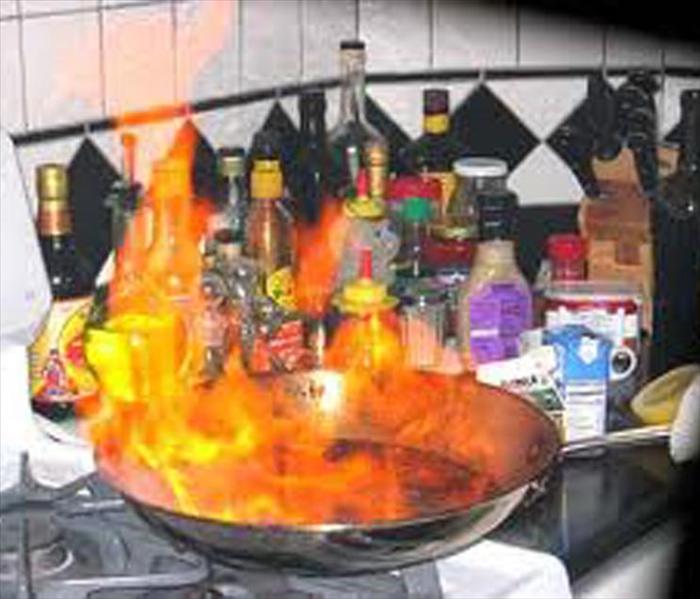Week 6 Question - Scavenger Hunt Contest Fall 2014
11/10/2014 (Permalink)
Did you know that according to FEMA, 1 out of 4 households in the US have no fire extinguisher at home? Used at the right time, on the right fire, and in the right way, an extinguisher can limit flame and smoke damage, and can even save your home.
There are five primary types of fire extinguishers, each designed to put out different kinds of fires. To put out a potential grease fire that may occur in your kitchen at home, you want to make sure your fire extinguisher is effective on which class of fire?
A. Class A fires
B. Class B fires
C. Class C fires
D. Class D fires
E. Class K fires
Click on the link above to select your answer. Once the pop-up window opens, hit "send" on your email to select your answer. If the pop-up does not work for you, please email your answer directly to SERVPROdave@gmail.com. You have until 11:59PM on Sunday, 11/16 to submit your answer.
Need a hint? "Hunt" in our article below!
With so many fire extinguishers to choose from, selecting the proper one for your home can be a daunting task. Everyone should have at least one fire extinguisher at home, but it's just as important to ensure you have the proper type of fire extinguisher. Fire protection experts recommend one for the kitchen, the garage, and workshop.
There are five primary types of fire extinguishers, each designed to put out different kinds of fires. Each fire extinguisher also has a numerical rating that serves as a guide for the amount of fire the extinguisher can handle. The higher the number, the more fire-fighting power. The following is a quick guide to help choose the right type of extinguisher:
For use with ordinary materials like cloth, wood and paper.
Often found in homes and businesses
For use with combustible and flammable liquids like grease, cooking oil, gasoline, and oil-based paints.
Often found in homes and businesses
For use with electrical equipment like appliances, tools, or other equipment that is plugged in.
Often found in homes and businesses For use with flammable metals Often found in factories
For use with vegetable oils, animal oils and fats in cooking appliances.
Often found in commercial kitchens (restaurants, cafeterias, catering businesses)
Water extinguishers or APW extinguishers (air-pressurized water) are suitable for class A fires only. Never use a water extinguisher on grease fires, electrical fires or class D fires - the flames will spread and make the fire bigger! Water extinguishers are filled with water and are typically pressurized with air. Again - water extinguishers can be very dangerous in the wrong type of situation. Only fight the fire if you're certain it contains ordinary combustible materials only.
Dry chemical extinguishers come in a variety of types and are suitable for a combination of class A, B and C fires. These are filled with foam or powder and pressurized with nitrogen.Dry chemical extinguishers have an advantage over CO2 extinguishers since they leave a non-flammable substance on the extinguished material, reducing the likelihood of re-ignition.
- BC - This is the regular type of dry chemical extinguisher. It is filled with sodium bicarbonate or potassium bicarbonate. The BC variety leaves a mildly corrosive residue which must be cleaned immediately to prevent any damage to materials.
- ABC - This is the multipurpose dry chemical extinguisher. The ABC type is filled with monoammonium phosphate, a yellow powder that leaves a sticky residue that may be damaging to electrical appliances such as a computer.
Carbon Dioxide (CO2). CO2 extinguishers contain carbon dioxide, a non-flammable gas, and are highly pressurized. The pressure is so great that it is not uncommon for bits of dry ice to shoot out the nozzle. They don't work very well on class A fires because they may not be able to displace enough oxygen to put the fire out, causing it to re-ignite.
These are only the common types of fire extinguishers. There are many others to choose from. Base your selection on the classification and the extinguisher's compatibility with the items you wish to protect.
It is vital to know what type of extinguisher you are using. Using the wrong type of extinguisher for the wrong type of fire can be life-threatening.
When operating a fire extinguisher, remember the word PASS:
- Pull the pin. Hold the extinguisher with the nozzle pointing away from you and release the locking mechanism.
- Aim low. Point the extinguisher at the base of the fire.
- Squeeze the lever slowly and evenly.
- Sweep the nozzle from side-to-side.





 24/7 Emergency Service
24/7 Emergency Service
